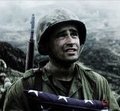GoodGuy
Posts: 1506
Joined: 5/17/2006
From: Cologne, Germany
Status: offline

|
quote:
ORIGINAL: Randomizer
Electro-boats were certainly more survivable that the older Type VII's and Type IX's but having been driven from the surface, the problems of locating convoys, command and control and massing firepower become insurrmountable and even today the diesel-electric submarine is a solitary hunter that is more a mobile minefield than a free-ranging hunter-killer. To contend, as many like to do that it would have won the war is ludicrous because it ignore everything but the impressive technology of the sub itself.
After the war the Allies did get a huge shock by the advanced state of German R & D into infrared technologies. However, why this is so is instructive in itself. Refusing to believe the evidence that the Enigma coding machine had been compromised or that Allied airborne and surface search radar was as effective as it really was, the Germans came to believe that the Allies were using some sort of infrared device.
No. Actually, around 1942/1943 (IIRC) German submarine commanders reported that Allied bombers and sea-planes would just appear from "nowhere", often from above the ceiling, trying to strafe or even bomb the U-boats. They suspected them to use a Radar, the possibility that the Allies could use radio direction finding was ruled out for quite some time (the Allies were using Huff-Duff since 1941 in fact), because various attacks happened even when radio silence was imposed.
Radio messages (meant to reach either the Uboat supreme commander Dönitz, or friendly subs in the area) often sealed a particular Uboat's fate, because the Allies used Huff-Duff to locate a sub or a group of subs, then - when they got in range - they used H2S to pinpoint the sub, bombed it or released depth charges, where the destroyers then took over with sonar to hunt it for hours.
As the German focus was on Radar, they came up with the Metox (1.8 - 4 meter waves), a warning device (passive radio antenna system) that could detect active radar devices. As the Brits constantly changed and refined the Radar technology, the Germans came to the wrong conclusion that the Metox' own characteristic radiation may be detected by imaginary devices on Allied ASW ships and planes. That was not the case.
In fact, the Brits had developed the Magnetron, allowing for wave lengths of 9,1 cm (initially), 3 cm and even 1,5 cm later on towards the end of the war, where the latter enabled them to even detect rain clouds.
The H2S Mark III emitted a 3cm wave which finally enabled bomber crews to distinguish between building areas and undeveloped areas (probably around 1944).
In turn, the German NAXOS device (1943?), used by Uboats and nightfighter planes (since British bombers used Radar for navigation and target acquisition), was able to detect the British H2S radar, giving a submarine the chance to dive and escape. The German nightfighters used the signals emitted by the H2S as beam that would lead the fighters to the spearheading units of the British bomber squadrons, as usually only these pathfinders (who were supposed to mark the target areas) had their H2S enabled. The German nighfighters received active radars later on, after the Naxos had become less effective.
The Magnetron was known in Germany, it received a patent in 1935. But the German military favoured the Klystron and employed it in their fixed Radar installations, given - they were not aware of the existence of H2S. The Germans were able to retrieve a H2S device from a crashed bomber (the screen had been destroyed on impact) in February 1943, but they could not figure purpose nor method of operation. Around one year later, the germans got their hands on a working screen, put the set on a flak-tower and were terrified when they turned on the device: They could see the surroundings along with all nearby flak-towers.
quote:
2. There was never any effort to rationally examine what the Allies were doing and how the Allies were doing it.
[]...... Capturing the Booth cavity-magnitron should have been a huge boon to electronics research but it was simply copied and used to produce their own centimetric radar.
Actually, they captured Allied equipment, tested and sometimes even incorporated them into their units, eg. Russian tanks, for one reason: They were more reliable and built for Russian winter conditions. Other equipment turned out to be inferior, so the Germans didn't bother to deal with that.
But even a thorough examination sometimes won't be sufficient to understand method of operation and purpose of a particular part.
quote:
There was nobody or no organization that dealt with pure research so that German electronics fell hopelessly behind.
Actually, German Radar technology was somewhat behind, indeed, but the Klystron used by the Germans was first favoured by Churchill himself, too, as he did not think the Magnetron would be superior. The British team developing the Klystron-approach argued that the Klystron would be the perfect device as it could be put into a leight-weight device, offering a level of miniaturization the Magnetron-team couldn't deliver. That might have been the main argument that won Churchill over - initially, I guess.
Call it coincidence or destiny, but at one point Churchill suddenly changed his mind, and placed an order for the H2S radar which used the magnetron, almost overstraining the H2S-team. The Klystron provided a shorter max range and quite some inaccuracy, compared to the Magnetron. So IMHO, this was a lucky outcome, as Churchill wasn't exactly well versed regarding technical details, he often appeared to be ignorant when it came to new inventions, many accounts describe him as a difficult person to deal with .... like a typical politician, despite his military background.
German research:
There were various research centers ran by the military, eg. the torpedo Research Center of the Navy, Luftwaffe and Army Centers working on the V-missiles, a tank test ground/range and artillery test range - both run by the Army, and various test squadrons performing prototype testing and testing of pre-production models. In addition to that, private companies conducted their own research, in quite some cases without government funding, until concepts were picked up by governmental or military agencies. Given, the coordination of armament efforts wasn't optimal, model parts and designs often weren't streamlined in order to offer interchangeability of parts or full mass production. When Albert Speer was appointed, coordination and streamlining improved, resulting in the German armament production-output peaking around mid-1944.
Also, research teams in universities contributed to the overall-effort.
The Allied structures were closer to the German organization than you think. The Ordnance department or the war department published a call for bids, where then armament factories submitted their designs. The Allied approach, especially the US approach, was then to employ large scale assembly lines, requiring a massive amount of manpower, or a sophisticated assembly line. German arms and vehicles often required extensive manual labour (where the amount of qualified workers had been reduced constantly, due to the military situation), because of their complicated designs and general lack of streamlining. It wasn't until 1943 that the Germans tried to optimize production processes.
You have to keep in mind that the Germans simply didn't need mobile radars until let's say around 1942, because German units were mainly on the offensive until late 1942. The Brits, in turn, had a strong interest in protecting their vital supply lines, so they were forced to come up with a solution to minimize the effectiveness of the German submarines, or - during the Battle of Britain in 1940 - the effectiveness of the German airforce, by installing the Chain Home system and introducing a new org. for their fighter groups. Both, radar and organization of fighters, was a reaction to the German threat, a reaction you imply to be an exclusive procedure in Germany only.
Further development of technologies during wartimes is mostly triggered by the strength or even superiority of enemy units. If you can clobber your enemy with a broomstick, you don't develop a flying broomstick with a laser gun. 
Armament production is in fact a series of processes aiming to counter a particular enemy weapon or superiority, be it a defensive or offensive weapon.
The Germans ignored some technology paths that could have been decisive or promising at least, and they were quite ignorant and conceited when it came to the question whether vital products were compromised/flawed or not.
The German scientists did not think the Enigma code could be cracked: they did not think the Brits would employ such a massive computer like they used in Bletchley Park, they did not come up with the thought that the original plans of the Polish "Bomba" could end up in British hands, or that a German sub could be captured - along with the codes and an original Enigma (the possession of the codes was the vital prize, not the capture of a working Enigma).
The German torpedo developers refused to modify the magnetic detonators for quite a while, as the torpedos that had been tested in their testing facility never failed. Sub commanders switched back to the mechanical fuse, as the magnetic ones weren't reliable enough.
Quite interestingly, the US subs in the Pacific experienced the very same flaws, forcing them to switch back to the old detonators, too. US test facilities claimed that they didn't experience the amount of duds experienced by US subs, same with the German research center. Both organizations were afraid to admit flaws in their test setups.
Allies and Axis ordnance agencies had to canalize efforts make decisions about what particular weapon design could turn out to be a useful arm in the field. The 76mm gun-upgrade for the Sherman, for example, was rather a failure, as its performance was pretty disappointing. US Ordnance passed when the Brits offered to share the guns they put in their Sherman Firefly variant. One could say that the US agency did not do their homework in that case. And that's exactly what happened on all sides, in many cases. The industrial power of the United States, which also boosted the British and some of the Russian efforts, was a massive backup that enabled the Allies to face the Germans with a seemingly neverending flow of arms, despite the fact that some of these mass products were inferior to some of the German counterparts.
The amount of factory output doesn't necessarily reflect a higher level of coordination or organization, but rather a wealth of resources and manpower, maybe assisted by simplified weapon design. It's true that German agencies often competed (with) or fought each other, but it wasn't like all the development teams totally worked in their own nutshells.
Quite contrary, some German companies, when ordered to takeover the production from other companies, were able to switch from let's say producing halftracks or trucks to a fully fledged production of airplanes (parts) or small arms within relatively short time frames. The economy of scarcity actually forced many companies to be more inventive.
quote:
.... V2 programs came about because of the inability of the Luftwaffe bomber forces to reach Britain with prohibitive losses
No, the V2 was based on a specification profile issued by the German "Heer" (Army branch of the Wehrmacht) in 1936. Versions A1-A3 were developed and tested until 1939, where the prototype A2 performed 2 successful take-offs in 1934. A3 take-offs all failed in 1937, but the redesigned A5 (in fact a modified A3) was successfully launched in 1938.
The development of the A4 (later designated V2) started in 1939, where the first take-offs in March 1942 failed, only the launch in October 1942 appeared to be successful. The development of the V flying bombs and missiles was initiated way before the Germans ceased to bomb British cities.
Also, German bombers started to bomb locations in Britain in early 1944, again, and - interestingly - in numbers. German bombers could reach British soil anytime, they just didn't have enough fuel to keep up a high number of sorties for more than 1 or 2 months. Furthermore, the bombardments had only a limited strategical value, means they could only serve in an attempt to lower the British morale.
quote:
... the Type XXI and XXIII U-Boats were developed to counter Allied ASW tactics and technology. It's amazing that the Uber-Nazi lobby cannot seem to accept that the Allies could do the same.
Well, the German XXI submarines were actually the result of a consistent further development with the task to turn submarines into real underwater vessels, instead of having to deal with the consequences that had to be faced when conventional submarines were deployed:
German and Allied submarines were rather boats with dive capabilities. The XXI's submerged speed was way higher than the speed maintained when surfaced. These boats' unmatched underwater speeds and low acoustic profile allowed for unusual manoeuvres and surprising approaches which made it hard to detect the subs with sonar.
The very last combat patrol performed by a XXI sub from April to May 1945 is a good example: The sub was able to close in on an Allied cruiser that was protected by a large group of destroyers. The German commander could calmly observe the cruiser and chase it, without being detected, solely due to its silent operation mode and speed. The German commander handed over the sub in a port in Norway, because he had received the message to cease all hostilities BEFORE he observed the cruiser, and he ran into the cruiser's commander - telling that he could have easily sunk the cruiser. The commander of the cruiser did not believe that claim, but was terrified when he heard details, proving that the report was true.
The XXI design influenced most if not all submarine designs after the war, and even the newest conventional German submarine (today) could close in on a US carrier group without being detected, during a military exercise in the Carribean a few years ago. The German commander took a normal camera and took a pic of the US carrier (as proof), leaving the US commanders astounded, maybe even terrified.
The XXI-design was more than just a reaction to Allied developments, it was a ground-breaking invention/solution way ahead of all submarine equipment used by the Allies at the time.
The Brits were just smart enough to direct British and US bomber groups to those shipyards where the XXIs had been assembled.
quote:
German aerodynamics research suffered a major blow when the high-speed wind tunnel at Peenemunde was destroyed during the RAF raid there in August 1943.
Afaik, the facilities had been moved to underground installations after the bombardment, just like so many facilities.
quote:
It's generally forgotten in the love affair with the ME-262 that Allied piston engined fighters killed more Swallows than Swallows killed of them or that the ME-262 threat never caused the British to redeploy the Gloster Meteor squadrons (which were fully operational and doing a fine job over England knocking down V1's) to the continent.
Thing was, the Brits hesitated to deploy bigger Meteor units to the continent (bigger than the small unit that had been re-deployed to Holland in Febr. 1945, actually), because they were afraid that the Germans could get their hands on their "secret weapon". The Me 262 had a higher max speed, was more agile and versatile, just the Jumo 004B engines turned out to be less reliable.
The Meteor suffered of a high level of what might translate to yaw vibrations, that occur at high (subsonic) speeds, which limited its fighter capabilities. The Meteor was rather a plane for training and evaluation purposes, or a ground-assault plane, than a fighter.
quote:
The reality is that the 262 was never much of a threat, effective counter-tactics were developed quickly and they could be largely ignored. Looks great in pictures though.
What counter-tactics? The 262s would have been a serious threat - if not a decisive weapon during the course to restore air superiority on the continent, if the Germans would have managed to come up with enough aviation fuel.
The Allied bombers were basically sitting ducks in the air, when they were approached by the Me 262s. They had no guns with auto-tracking, so the only counter-tactic was to employ changes in flight formations, but these had been introduced in 1942 or 1943 already.
< Message edited by GoodGuy -- 9/20/2009 12:27:11 AM >
_____________________________
"Aw Nuts"
General Anthony McAuliffe
December 22nd, 1944
Bastogne
---
"I've always felt that the AA (Alied Assault engine) had the potential to be [....] big."
Tim Stone
8th of August, 2006
|
 Printable Version
Printable Version


























 New Messages
New Messages No New Messages
No New Messages Hot Topic w/ New Messages
Hot Topic w/ New Messages Hot Topic w/o New Messages
Hot Topic w/o New Messages Locked w/ New Messages
Locked w/ New Messages Locked w/o New Messages
Locked w/o New Messages Post New Thread
Post New Thread